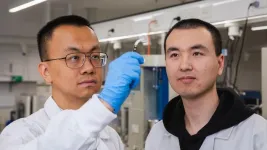(Press-News.org) CHAPEL HILL, NC – UNC Lineberger Comprehensive Cancer Center has been selected as one of nine national research sites for the National Cancer Institute’s (NCI), part of the National Institutes of Health, newly launched Cancer Screening Research Network (CSRN), which will evaluate promising and emerging cancer screening technologies.
Supporting the Biden-Harris Administration’s Cancer Moonshot initiative, the CSRN will conduct large, multi-center cancer screening studies with diverse populations in a variety of healthcare settings. The studies are designed to identify technologies that can detect cancers and pre-cancerous lesions before symptoms develop, and thereby reduce cancer incidence and cancer-related morbidity and mortality.
“NCI has launched the Cancer Screening Research Network to evaluate a variety of different technologies for the purpose of cancer screening,” said Lori M. Minasian, MD, deputy director of NCI’s Division of Cancer Prevention. “Detecting cancer early is not enough to improve people’s lives. Through the Cancer Screening Research Network, we’re going to study whether using these new technologies will make a difference in people’s lives.”
Daniel Reuland, MD, MPH, Louise Henderson, PhD, MSPH, and Carrie Lee, MD, MPH, will lead the UNC Lineberger Accrual, Enrollment, and Screening Site (ACCESS) Hub.
“In our role as an ACCESS Hub, we will build on UNC Lineberger’s depth and breadth in designing and conducting innovative interventional cancer screening studies and clinical trials, and developing and analyzing large, complex data sets related to cancer screening,” said Reuland, professor of medicine at the UNC School of Medicine and co-director of UNC Lineberger’s Carolina Cancer Screening Initiative. “Equally important, by partnering with clinical sites from across the state of North Carolina, we’ll be able to include a diverse population, in terms of race, age, education, income, and one that has a large rural component. This will help the research findings to be more widely applicable to populations and communities across the U.S.”
The CSRN will investigate new and developing screening technologies to see if the insights they generate are effective, accurate and provide a clinical benefit for patients.
Later this year, the CSRN will initiate the Vanguard Study on Multi-Cancer Detection (MCD) tests. Also known as liquid biopsies, MCD tests analyze blood and other body fluids for biological substances, including circulating cancer DNA fragments, that could suggest the presence of cancer. The study will enroll up to 24,000 people to inform the design of a much larger randomized controlled trial involving about 225,000 people. This larger trial will evaluate whether the benefits of using MCD tests to screen for cancer outweigh the harms, and whether they can detect cancer early in a way that reduces deaths.
“Cancer screening currently involves imaging tests or other medical procedures for several types of cancer, yet approximately half of cancer deaths occur in cancers with no current screening test,” said Henderson, professor of radiology at UNC School of Medicine and co-director of UNC Lineberger’s Carolina Cancer Screening Initiative. “MCD tests offer the promise of early detection for many different types of cancer across organ sites simultaneously. While there is a lot of excitement around MCD tests and their potential to revolutionize how we screen for cancer, the net benefits are unknown.”
Lee, professor of medicine at UNC School of Medicine and medical director of UNC Lineberger’s Clinical Trials Office, said it is critical to generate more scientific evidence about which cancer diagnostic tests are beneficial and improve outcomes, and which ones are not.
“Sometimes tests can produce results that are not meaningful or actionable, and these results can cause people to have undue anxiety,” Lee said. “By conducting scientifically rigorous studies of cancer screening technologies, we want to develop a better understanding about whether a positive test result is actually associated with a cancer diagnosis, and whether early detection will have a meaningful impact on the individual’s prognosis and survival.”
END
UNC Lineberger named as a national research hub for NIH cancer screening study
2024-02-21
ELSE PRESS RELEASES FROM THIS DATE:
New study suggests target steps per day for reduced risk of heart failure
2024-02-21
BUFFALO, N.Y. – The science is clear that movement is good for our bodies as we age. But just how much physical activity is beneficial for people over 60? A new study from the University at Buffalo provides an answer, and it’s not 10,000 steps per day.
In fact, the study — published Feb. 21 in JAMA Cardiology — of nearly 6,000 U.S. women aged 63-99 reports that, on average, 3,600 steps per day at a normal pace was associated with a 26% lower risk of developing heart failure.
The observational study from the Women’s Health Initiative ...
NIH launches research network to evaluate emerging cancer screening technologies
2024-02-21
The National Institutes of Health (NIH) has launched a clinical trials network to evaluate emerging technologies for cancer screening. The Cancer Screening Research Network (CSRN) will support the Biden-Harris administration’s Cancer Moonshot℠ by investigating how to identify cancers earlier, when they may be easier to treat. Eight groups have received funding from the National Cancer Institute (NCI), part of NIH, to carry out the initial activities of the network.
“There are many cancers we still cannot reliably ...
Evidence review: Maternal mental conditions drive climbing death rate in U.S.
2024-02-21
WASHINGTON (Feb. 21, 2024) – Painting a sobering picture, a research team led by Children’s National Hospital culled years of data demonstrating that maternal mental illness is an under-recognized contributor to the death of new mothers. They are calling for urgent action to address this public health crisis in the latest edition of JAMA Psychiatry.
Backed by dozens of peer-reviewed studies and health policy sources, the journal’s special communication comes as maternal mortality soars ...
Scientists from IOCB Prague have improved materials for reconstructive and plastic surgery
2024-02-21
Researchers from IOCB Prague and Ghent University have been working on improving the properties of gelatin-based materials, thereby expanding the possibilities of their use mainly in medicine. In a paper published in ACS Applied Engineering Materials, they have presented 3D-printable materials that can be easily monitored using an X-ray machine or through computed tomography (CT).
Gelatin-based materials have been a hot topic of research in the last ten years because they are straightforward to produce, non-toxic, inexpensive, ...
Nanoscale manipulation of exciton–trion interconversion in a MoSe2 monolayer via tip-enhanced cavity-spectroscopy
2024-02-21
In a significant advancement for next-generation semiconductors, a collaborative research team, led by Professor Kyoung-Duck Park and Mingu Kang in the Department of Physics at POSTECH, Professor Yong Doug Suh in the Department of Chemistry at UNIST, who concurrently holds the position of Associate Director at the IBS Center for Multidimensional Carbon Materials (CMCM), and Professor Hyun Seok Lee in the Department of Physics at Chungbuk National University, has made groundbreaking discoveries in the field of two-dimensional (2D) semiconductors. Their findings, published in Nano Letters, shed light on the generation and control of trions, providing ...
Hyperbaric oxygen therapy tested for post-covid conditions
2024-02-21
High-dose pressurized oxygen can stress out old immune cells, leaving behind a younger, better functioning immune system. It helped with acute COVID, and now Anders Kjellberg is testing the method for post-covid as well.
Hyperbaric oxygen therapy, giving patients 100 percent oxygen at a pressure corresponding to 10-20 meters below sea level, has been around for almost 100 years. But the method lacks modern evidence from clinical studies, which also means that there is a lack of knowledge about dosage, all patients receive the same dose.
"When I started my research, I wanted to find out how the treatment should be dosed to different patients," says ...
Revolutionary breakthrough in solar energy: World’s most efficient QD solar cells developed
2024-02-21
A groundbreaking research breakthrough in solar energy has propelled the development of the world’s most efficient quantum dot (QD) solar cell, marking a significant leap towards the commercialization of next-generation solar cells. This cutting-edge QD solution and device have demonstrated exceptional performance, retaining their efficiency even after long-term storage. Led by Professor Sung-Yeon Jang from the School of Energy and Chemical Engineering at UNIST, a team of researchers has unveiled ...
New water batteries stay cool under pressure
2024-02-21
A global team of researchers and industry collaborators led by RMIT University has invented recyclable ‘water batteries’ that won’t catch fire or explode.
Lithium-ion energy storage dominates the market due to its technological maturity, but its suitability for large-scale grid energy storage is limited by safety concerns with the volatile materials inside.
Lead researcher Distinguished Professor Tianyi Ma said their batteries were at the cutting edge of an emerging field of aqueous energy storage devices, with breakthroughs that significantly improve the technology’s performance and lifespan.
“What ...
Focus on patient experience can improve diabetes care
2024-02-21
WASHINGTON—Health care providers who treat diabetes need to think beyond the clinical numbers, such as solely focusing on a person’s glucose goals. Taking the patient experience into account can improve the quality of care and facilitate attainment of treatment goals, according to a new position statement published in the Endocrine Society’s Journal of Clinical Endocrinology & Metabolism.
The position statement reflects the consensus of two virtual roundtables the Endocrine Society held in 2022. Participants ...
KIER’s success in the development of the world's top-level semi-transparent perovskite solar cells
2024-02-21
The Photovoltaics Research Department of the Korea Institute of Energy Research (hereafter KIER), working with the KIER Energy AI and Computational Science Lab, has achieved advancements in the stability and efficiency of semi-transparent perovskite solar cells. These cells have potential use in building windows and tandem solar cells*. The semi-transparent solar cells achieved a record-breaking efficiency of 21.68%, making them the most efficient amongst the perovskite solar cells using transparent electrodes in the world. Additionally, they showed ...








